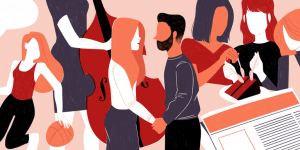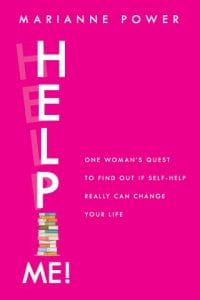
Illustration by Erin Lux
I had spent the last four hours staring at the man in my coffee shop, nursing cold coffees and pretending to work while trying to get the courage to talk to him. Beardy, scruffy and intellectual-looking, he was scribbling in a notepad and I imagined he was writing a brilliant book or an equally-brilliant screenplay. Sometimes he’d catch me looking at him; I’d panic and look away, cheeks burning.
I texted my flatmate for advice. “Go up and say hello to him,” she texted back.
“I can’t, I’m scared,” I replied.
She commanded me to just “Shut up and do it.”
And so, I took my caffeinated heart and shaky limbs and walked right up to his table. He looked at me and I looked at him. For a second the world stopped. I prepared to be rejected. Horribly, humiliatingly rejected. And that was the point.
A few months before this I’d set myself a challenge to fix my broke, hungover, single, 36-year-old existence by following the rules of different self-help books—choosing one for every month of the year. I’d already jumped out of a plane, modeled naked,and done stand-up comedy in the name of Feel the Fear and Do it Anyway. I’d made vision boards and road-tested my dream car in accordance with The Secret. I was now on month four of my project, following a self-help approach called Rejection Therapy.
This masochistic form of self-improvement challenges you to be rejected every day by another human. The idea behind it is that we all live in fear of rejection and it stops us from going after the things we want in life—whether that’s a man or a promotion or even just making a new friend. By actively seeking it out we learn that rejection doesn’t kill us and that people often say “yes” when you think they’ll say “no”.
“It stops us from going after the things we want in life—whether that’s a man or a promotion.”
I started with small rejections, such as asking for free drink in my local bar and a discount from my phone provider. I was stunned by how much it hurt to hear “no”. I felt grubby and greedy for asking. I’d say “hello” to strangers on the street and when they looked at me like I was crazy, I felt a physical pain. Even though I would never see these people again, their rejection hurt me. I didn’t want them to think I was weird. I’m a very normal person with friends! I wanted to shout. I’m just doing this for an experiment!
The opinions of others matter so much because in our caveman days, our survival used to depend on being accepted by the group; if we weren’t part of the group you were more likely to be attacked by a sabre-toothed tiger. That’s why now, even thousands of years later, rejection can feel like death, even if it’s just somebody not returning your email.
But I continued and things began to get better.
One morning, I walked past a basketball court and asked a group of teenage boys if I could join in their game. I expected them to look at me like I was a mad old woman. They didn’t. “Sure,” they shrugged, before giving me a 20-minute lesson on how to shoot hoops. When I told them about Rejection Therapy, they told me how hard it is to approach girls and walk back to their friends after they get blown out. I told them that I’d try to chat up a guy during my challenge. “No guy would reject you,” one told me. I beamed with delight. “Yeah, cos, even if they don’t fancy you, they still want to get some,” said his friend. Charming.
But I enjoyed swapping chat up techniques with teenage boys. It made me see that, underneath it all, we’re all the same.I asked to join the band playing in our local bar—they said yes and I had a few minutes of joy plucking the strings of a double bass. I invited myself to join a table of women who looked like they were having fun in a local restaurant. “My friends are boring me; can I join you guys?” I asked. “Sure,” they said. We ate desserts together and I learned more than I needed to know about what it’s like to have sex after childbirth.
Rejection Therapy opened up conversations and connections and experiences that I would never have had without it. Emboldened by this success, I faced professional rejection.
As a freelance writer I should have been pitching to new publications all the time but I never had the confidence. In Rejection Therapy, I emailed every editor I could get an email address for. I made the boldest request I could think of; asking to be given a weekly column about the small things we can do to be happier. I was expecting silence. What I got was an email from one editor saying she admired my writing. Three weeks later my first column appeared. It still runs every week. It’s the size of a match box, but who cares? I have a weekly newspaper column!
It showed me that your career can be transformed just by daring to ask for what you want, and by continuing to knock on doors even when you get told no. Which now left the big one: being rejected by a man.
“Rejection can feel like death, even if it’s just somebody not returning your email.”
I have never had confidence when it comes to the opposite sex. Usually I couldn’t even smile at a guy I liked, let alone talk to him. I was too busy imagining all the ways I wasn’t good enough—not pretty enough, not blonde enough. The rejection, I feared, would feel unbearable. It would confirm all the worst things I thought about myself, which was that, deep down, there was something wrong with me, something unlovable. And so I avoided it completely. Until Rejection Therapy.
After a few seconds of stunned silence, Mr. Beardy smiled and asked if I’d like to sit down. I said yes.
He held out his hand and told me his name, which sounded Greek. So I asked him if he was Greek. He said yes. He asked me if I spoke Greek, I said no. He asked me if I’d been there. I started babbling about being in Athens once and it being very hot. “I basically sweated my way around the Acropolis,” I said, internally kicking myself for bringing up sweat in the first two minutes. But he laughed and then we were properly chatting.
When the coffee shop started closing, he asked me if I wanted to get a glass of wine. We moved to a bar and he told me he had noticed me, too, and that he would have kicked himself for not coming up to me. He told me that he will say hello to a woman if she smiles at him three times. This seemed like a very precise approach and it made me think: I’d always thought that the girls who got the guys did so because they were prettier and skinnier than me. Maybe they were just smiling more?
“I was stunned when you came up to me. My heart was beating like crazy,” he confessed. I was surprised—he’d seemed so calm. I figured he did this kind of thing all the time.
He laughed when I told him this. “No, not at all. This is the loveliest thing to happen to me in a long time,” he said.
I wondered then whether everything I thought about men—and life—was wrong. I had this story that I was not the kind of woman that men liked, but maybe that wasn’t true? I realized that for all my fear of rejection, I’d hardly ever actually been rejected because I’d spent years avoiding it; with work, with friends, with love. I saw that the person who had rejected me most in life was myself—and that had to stop.
After our wine, he walked me back to my train, kissed me, and asked if I wanted to meet up again. I discovered that life can change the moment you stop making excuses and do the things that scare you. Even if that’s just saying “hello”.
From: Harper’s BAZAAR US




